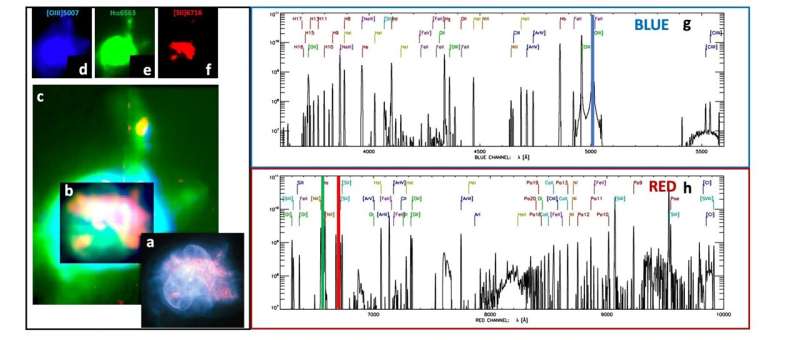This article has been reviewed according to Science X's editorial process and policies. Editors have highlighted the following attributes while ensuring the content's credibility:
fact-checked
trusted source
proofread
New observatory instrument sets its sights on Turtle Nebula

A new instrument for studying a web of filaments that connects galaxies across the universe has captured its first image, a milestone known in astronomy as "first light." The Keck Cosmic Reionization Mapper (KCRM) at the W.M. Keck Observatory atop Maunakea summit in Hawaiʻi, will provide detailed maps of gas around dying stars and other cosmic objects, and it will map the so-called cosmic web that links and feeds galaxies. The instrument was recently installed next to its partner, the Keck Cosmic Web Imager (KCWI), which began operations in 2017.
"I envisioned this instrument as a two-armed imaging spectrograph back in 2007, based on our Palomar Cosmic Web Imager, but it was a long road to get the funding, so we split the instrument into two halves," says Christopher Martin, the instrument's principal investigator and a professor of physics at Caltech. "KCWI was already doing phenomenal science with one arm tied behind its back, so now it's off to the races. It is fitting that our first-light image shows two 'arms' of the turtle nebula. We would not have made it without the work of our fantastic instrument team and support from Caltech, the Keck Observatory, the National Science Foundation, and a generous anonymous donor."
The first-light image shows the Turtle Nebula, or NGC 6210, which consists of a hot, dying star that has blown off its outer envelope of material. In the image, which combines data from both KCRM and KCWI, two stubby, gaseous "arms" can be seen protruding from the shell of the "turtle," demonstrating the power of the instruments to see faint gas in the cosmos. "The arms were captured easily in less than a minute of observation," says Martin, who also serves as director of Caltech's Optical Observatories. While the arms had been seen before, this is the first time their spectral details have been completely mapped.
The spectral image, which covers most of the optical wavelength range of KCWI and KCRM, from 350 to 1,000 nanometers, was captured in about five minutes. More than 80 individual spectral emission lines from many elements in the periodic table were easily detected.

KCRM completes the original KCWI instrument concept to produce one imaging spectrograph that is among the best in the world for taking spectral images of cosmic objects. That means that astronomers can investigate every pixel within an imaged object over the full wavelength coverage of the instrument. While KCWI covers wavelengths ranging from 350 to 560 nanometers—or the blue end of the visible-light spectrum—KCRM simultaneously captures light with wavelengths between 560 to 1,080 nanometers, or the red end of the spectrum.
Because light from the distance universe is stretched (shifted) to longer, redder wavelengths due to the expansion of space, KCRM can see farther back in time than KCWI. This means it is particularly suited to investigating the mysteries surrounding the era after the Big Bang, when the cosmos was a toddler and light from the first stars transitioned the universe from darkness to light. During this period, called the epoch of reionization (hence, KCRM's name), the first stars and galaxies began to form, emitting radiation powerful enough to burn through the dark, dense fog of cool hydrogen gas that filled the universe.
In addition to studying the cosmic web and the epoch of reionization, KCWI and KCRM can observe powerful winds that rush out of galaxies, jets of gas around young stars, black holes, and more.
"We are excited and proud to have merged KCRM with KCWI," says Mateusz Matuszewski, a senior instrument scientist at Caltech. We look forward to the exciting discoveries that we and the observing community will make with this new instrument. And we are grateful to the engineering teams at Caltech, UCO/Lick Observatory, and Keck Observatory for making this instrument a reality."
Provided by California Institute of Technology




















